As the beginning of 2008 Olympic Games approaches, I thought it'd be good to read about the Capital City of China - Beijing and all of its marvels. This very nicely written and informative article will give you the overview of the city's splendid past and present, along with some important travel tips.
By Kaye Madsen
Photos by Rick & Kaye Madsen
Even as a child I was drawn to exotic destinations! By the time I was eight I had studied the photographs in my grandparent's series of Stoddard's Lectures and knew that one-day I must see these wonders for myself. Now the day was at hand. The thrill of anticipation raced through my mind as my flight entered the final approach to Beijing. I would have eight days of adventure exploring her nooks and crannies.
We arrived in the evening at the recently opened international airport, which was so sleek, and modern that it bore no resemblance to the China I'd envisioned. I quickly realized that China is a country of sharp contrasts and that Beijing reflects the many facets of its culture.
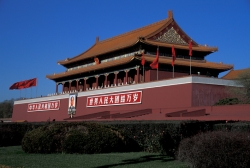 Our first day dawned bright and clear with a brilliant blue sky which contrasted vividly with the red of Tian'anmen gate. We spent the morning walking around the square, observing the great landmarks of modern China, which included the Great Hall of the People, the Chairman Mao Memorial Hall and the Monument to the People's Heroes. On our first two days of sight seeing we toured with a group of twelve guided by, Jack, (all Chinese guides seem to have adopted western names). He enthusiastically briefed us on the significance of each building.
Our first day dawned bright and clear with a brilliant blue sky which contrasted vividly with the red of Tian'anmen gate. We spent the morning walking around the square, observing the great landmarks of modern China, which included the Great Hall of the People, the Chairman Mao Memorial Hall and the Monument to the People's Heroes. On our first two days of sight seeing we toured with a group of twelve guided by, Jack, (all Chinese guides seem to have adopted western names). He enthusiastically briefed us on the significance of each building.
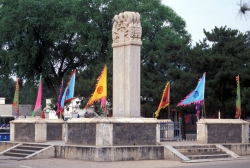 In the afternoon we visited the Forbidden City or Palace Museum as it is now called. It was declared a World Heritage Site in 1987 and has undergone extensive restorations since then. Home to the Ming and Qing dynasties from 1420 to 1911, it is an incredible complex consisting of 9,999 rooms built by over a million workers and over 100,000 craftsmen. Jack explained the symbolic significance in each phase of the architecture, in the numbers of steps, in the colours used for decorating, in the animal statues on the grounds, and in the direction which rooms and gates face. I was awed by the beauty and harmony of the palace and could imagine it bustling with activity many long years ago. It is impressive even without furnishings and treasures, which were moved to Taiwan in 1949.
In the afternoon we visited the Forbidden City or Palace Museum as it is now called. It was declared a World Heritage Site in 1987 and has undergone extensive restorations since then. Home to the Ming and Qing dynasties from 1420 to 1911, it is an incredible complex consisting of 9,999 rooms built by over a million workers and over 100,000 craftsmen. Jack explained the symbolic significance in each phase of the architecture, in the numbers of steps, in the colours used for decorating, in the animal statues on the grounds, and in the direction which rooms and gates face. I was awed by the beauty and harmony of the palace and could imagine it bustling with activity many long years ago. It is impressive even without furnishings and treasures, which were moved to Taiwan in 1949.
No trip to China would be complete without an evening of entertainment at the Peking Opera so we decided to go to the Zhonge Theatre for a shortened version of the traditional production which would normally go on for many hours. The cast performed in elaborate costumes and makeup. Fortunately side screens told the story in English, as it was difficult to follow. I'm musically "challenged" but even my travelling companion who is a musician didn't really warm up to the Chinese opera.
Another night we attended the Chinese acrobat's program. The troupe included men, women and children. What a delight to watch as they tumbled, juggled, balanced and performed amazing feats to lilting melodious tunes. Their movements with costumes and props created a wonderful kaleidoscope of motion, music and colour. It was an evening of pure magic.
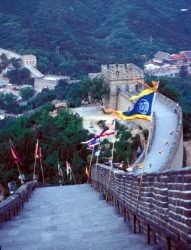 On our second day of touring we traveled by van to the Jinshanling gate of the Great Wall. I was happy to visit that section of wall because it is not as commercialized an area as several others. Instead of a cable car to ascend the wall we trekked up the steep steps which is no mean feat. The stairs are not uniform, some very far apart but others close together, some very narrow and some quite wide. The heavy iron railing along one side certainly helped me reach a point where I could look at the many miles of wall visible in each direction. To view the wall from such a vantage point was quite incredible and to imagine the astronauts observing it from space was quite unbelievable.
On our second day of touring we traveled by van to the Jinshanling gate of the Great Wall. I was happy to visit that section of wall because it is not as commercialized an area as several others. Instead of a cable car to ascend the wall we trekked up the steep steps which is no mean feat. The stairs are not uniform, some very far apart but others close together, some very narrow and some quite wide. The heavy iron railing along one side certainly helped me reach a point where I could look at the many miles of wall visible in each direction. To view the wall from such a vantage point was quite incredible and to imagine the astronauts observing it from space was quite unbelievable.
From the Great Wall we drove to the Ming Tombs where most of the emperors of the Ming Dynasty were buried between 1368 and 1644. Before entering the tombs we looked at interesting museum displays of treasures from the dynasties. We then climbed down one hundred steps to reach one of the two tombs, which are open to the public. (Afterwards, as I ascended the stairs I promised myself that I'd be sure to get in shape before my next vacation.) As we walked along the Spirit Way the setting sun cast a mystical glow on the larger than life sized stone carvings of animals and emperors which line the walk.
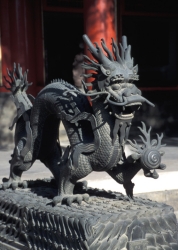 That night we feasted on the renowned Peking Duck in the elegant Hotel Kun Lun. With much ceremony our waiter carved up the duck at our table. He served us small thin pancakes onto which he spooned sauce, vegetables and duck morsels mixed with bits of crispy skin accompanied by a rice wine which only tasted decent after the third glass. Instead of wine some members of our party opted for Chinese beer. It is served from larger bottles than in the western world and thus a bottle is shared.
That night we feasted on the renowned Peking Duck in the elegant Hotel Kun Lun. With much ceremony our waiter carved up the duck at our table. He served us small thin pancakes onto which he spooned sauce, vegetables and duck morsels mixed with bits of crispy skin accompanied by a rice wine which only tasted decent after the third glass. Instead of wine some members of our party opted for Chinese beer. It is served from larger bottles than in the western world and thus a bottle is shared.
After two days of guided sightseeing we decided to spend a day venturing out on our own. Befor leaving the hotel we had the concierge write our hotel's name on a card in Chinese characters. That way, we could give it to a taxi driver if we should get lost. Since our hotel was centrally located we chose to walk to the nearby winding Silk Road. Gone are the days when the merchants sold real silks to the Chinese people! Now the market caters to tourists. None the less, it was fun to browse the rows of stalls selling cashmere sweaters, handbags, luggage, "North Face" jackets, quilts, scarves, cloisonné and almost anything else one could wish for. The prices were so cheap but I'm rather jaded so bought only a few trinkets rather than be disappointed with goods that didn't live up to my expectations. At each booth we were greeted with smiles and sales people eager to practice their limited English. When I indicated to one stall keeper that I wasn't interested in an item after she'd told me the price she explained that I must then suggest another price, back and forth until I bought the article - an amusing lesson in bargaining. The experience was fun and we enjoyed the morning immensely.
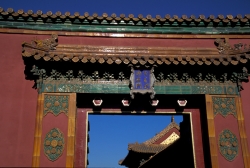 After a quick lunch we walked down the street to the Friendship Store which is operated by the Chinese government. It is truly a treasure trove of authentic Chinese arts and crafts. It has many floors and departments. As I gazed at the wonderful treasures I felt I was touring a museum. The large handmade pure silk carpets were gorgeous, as was the carved and semi-precious gemstone inlaid furniture. Beautifully patterned silk fabrics were available in quality rarely seen. I loved the department selling toys and was enthralled with the painted silk-like fabric kites. There were birds, butterflies and fish in every rainbow hue, truly so beautiful that I couldn't resist buying. I paid for my purchases and waited while they were packaged. Even the boxes were works of art! Our final stop of the day was at a department store, bustling and crowded. I was keen to find a cashmere throw like those I'd seen in America. And the one I found was perfect, a cream, soft, luxurious work of art, costing only a fourth of its price at home.
After a quick lunch we walked down the street to the Friendship Store which is operated by the Chinese government. It is truly a treasure trove of authentic Chinese arts and crafts. It has many floors and departments. As I gazed at the wonderful treasures I felt I was touring a museum. The large handmade pure silk carpets were gorgeous, as was the carved and semi-precious gemstone inlaid furniture. Beautifully patterned silk fabrics were available in quality rarely seen. I loved the department selling toys and was enthralled with the painted silk-like fabric kites. There were birds, butterflies and fish in every rainbow hue, truly so beautiful that I couldn't resist buying. I paid for my purchases and waited while they were packaged. Even the boxes were works of art! Our final stop of the day was at a department store, bustling and crowded. I was keen to find a cashmere throw like those I'd seen in America. And the one I found was perfect, a cream, soft, luxurious work of art, costing only a fourth of its price at home.
Through contacts in North America we booked a private guide for another two days of sight seeing. Mack was a Ph.D. student who had never been outside China. His English was perfect so I could hardly believe that he had not studied in an English speaking country. He loved China and shared that love with us, making our travel experience all the richer. Our touring with him was all done on public transportation, large buses, small buses, subway and taxi. At 5'8" I found that these modes of transportation did not suit my size. They were built for miniature people. Despite a bit of a backache, I survived!
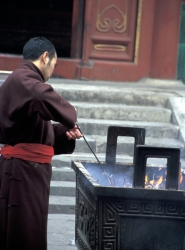 With Mack we saw the Temple of Heaven. It was a foggy morning and the mist gave the temple complex an almost mystical appearance. In sharp contrast with the spiritual qualities of the temple, many people whose faces were covered with surgical masks busily swept the grounds with their twig brooms. We also visited the interesting Lama Temple where we watched monks and Chinese citizens light incense in their rituals of worship. At noon we stopped at a restaurant for "hot pot' where you are provided the ingredients and cook them yourself in boiling broth in a container called a Mongolian hot pot. We certainly were glad to have Mack to order for us. He chose well and our meal was so delicious. Following lunch we wandered through the hutongs, ancient narrow streets where the people live. There we saw bicycle trucks making deliveries. A group of men sat at a stone table playing checkers. On one corner there was a stall selling tasty looking hot cooked chicken on bamboo skewers. We felt very fortunate to have such a terrific guide to show us the people's side of Beijing.
With Mack we saw the Temple of Heaven. It was a foggy morning and the mist gave the temple complex an almost mystical appearance. In sharp contrast with the spiritual qualities of the temple, many people whose faces were covered with surgical masks busily swept the grounds with their twig brooms. We also visited the interesting Lama Temple where we watched monks and Chinese citizens light incense in their rituals of worship. At noon we stopped at a restaurant for "hot pot' where you are provided the ingredients and cook them yourself in boiling broth in a container called a Mongolian hot pot. We certainly were glad to have Mack to order for us. He chose well and our meal was so delicious. Following lunch we wandered through the hutongs, ancient narrow streets where the people live. There we saw bicycle trucks making deliveries. A group of men sat at a stone table playing checkers. On one corner there was a stall selling tasty looking hot cooked chicken on bamboo skewers. We felt very fortunate to have such a terrific guide to show us the people's side of Beijing.
On our second day with Mack we took a taxi to the Summer Palace. This resort was built in the eighteenth century as a royal retreat to avoid the stifling summer temperatures in Peking (now called Beijing). The lavish long painted corridor and the elegant Marble Boat reveal a time of sumptuous excesses. In such a setting of beautiful gardens, ponds and lakes the rulers would have been remote from the toils of their subjects. During our return taxi ride to the city Mack pointed out the empty building shells along the main streets. They were, he told us, replacements for disintegrating buildings and were constructed to give Beijing a good appearance for the officials who would visit to review Beijing's Olympic bid. Money wasn't available to complete the projects so all the facades were constructed and eventually the structures would be completed.
 The one stop that I requested on our sightseeing expedition which Mack had difficulty understanding was a visit to the Beijing Zoo. I love bears and knew they have a very large panda habitat and breeding program. He humored me and we went to see the pandas, my first sight of real live pandas. For a delightful half hour we observed five bears, a couple cavorting playfully, oblivious to our presence. Even Mack admitted to thoroughly enjoying the diversion.
The one stop that I requested on our sightseeing expedition which Mack had difficulty understanding was a visit to the Beijing Zoo. I love bears and knew they have a very large panda habitat and breeding program. He humored me and we went to see the pandas, my first sight of real live pandas. For a delightful half hour we observed five bears, a couple cavorting playfully, oblivious to our presence. Even Mack admitted to thoroughly enjoying the diversion.
My visit to Beijing and the nearby countryside certainly exceeded my expectations. The architecture and intricate craftsmanship were amazing and I gained a new appreciation for the harmony and spiritual qualities of the Chinese culture. I loved all the Chinese people I met because they were so friendly and greeted us with happy, smiling faces. My only regrets were too few days to explore but now my interest in China is piqued and my list of places that I want to see in the country has grown. Before too long I will return.
About:
King Wu was the first to declare Beijing the capital city in 1057 BC. Subsequently, the city has gone by the names of Ji, Zhongdu, Dadu, and finally Beijing when the Ming Dynasty Emperor ChengZu chose the name in 1421. Beijing was also known as Peking by the Western world before 1949. Beijing has a whole area of 16808 sq km (about 6500 sq mi), stretching 160 kilometres from east to west and over 180 kilometres north to south. She has 18 districts and counties with Dongcheng, Xicheng, Xuanwu, Chongwen, Chaoyang, Haidian, Fengtai and Shijingshan in the surburbs and Fangshan, Mengtougou, Changping, Tongxian, Shunyi, Daxing, Huairou, Miyun, Pinggu and Yianqing in the outer suburbs. Population in Beijing is about 12 million.
Where To Stay:
ZD Chinats provides a list of hotels from inexpensive and comfortable to world class luxury with prices to match.
What To Do:
A long history has left numerous famous historical sites which possess great aesthetic and cultural values. The Great Wall, a huge project begun more than 2,000 years ago, meanders through mountains and valleys for hundreds of kilometers in the region of Beijing. On the Shijing Mountain,there are more than 340 volumes of 15,000 stone tablets carved with Buddhist scriptures. The big Yongle Bell, cast at one go with over 230,000 characters on it , weighs 46.5 tons and shows the exquisite casting technology of ancient China. The Forbidden City, the largest ancient architectural complex extant today, is splendid crystallization of ancient Chinese architectural art. Walking in the city, one may find many places worth a second visit. These include mansions, gardens , gate towers , temples, former residences of celebrities and places where many historical events took place.
Climate:
Situated in the northeastern part of China at an elevation of 43.5m above sea level, the climate in Beijing is of the continental type, with cold and dry winters and hot summers. January is the coldest month (-4 Celsius), while July the warmest (26 Celsius).
The article was originally published at: 21st Century Adventures
















































